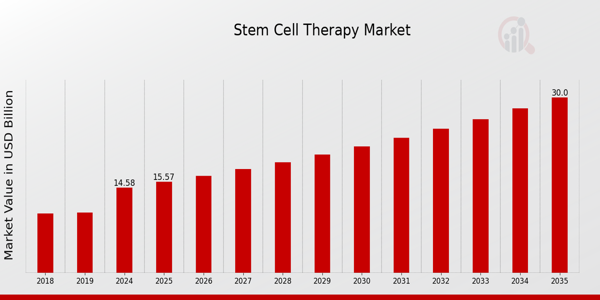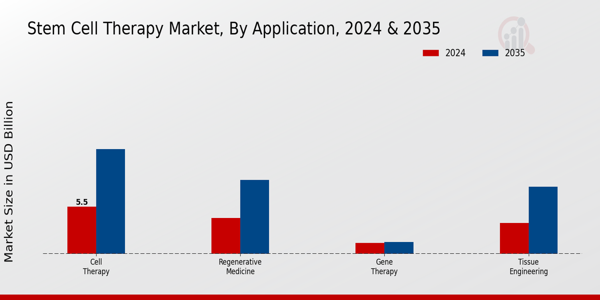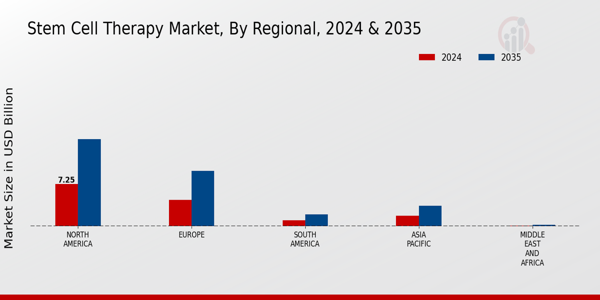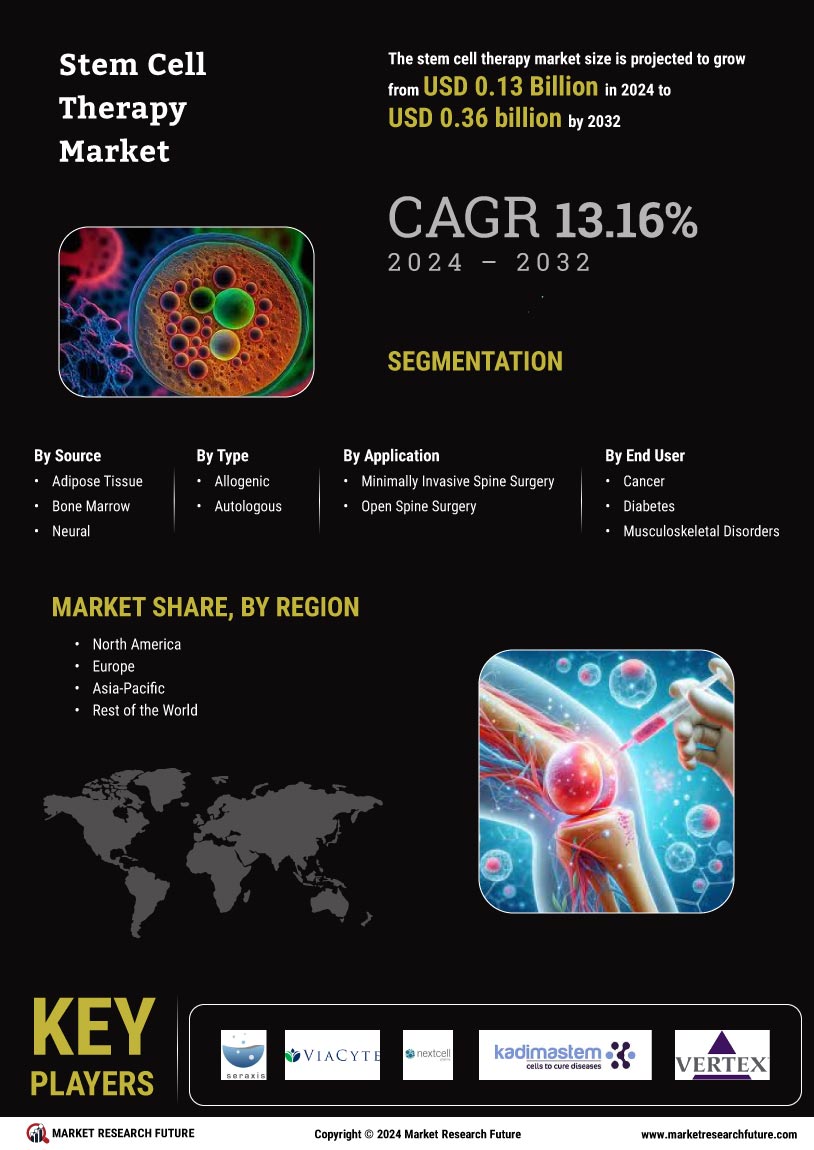Global Stem Cell Therapy Market Overview
As per MRFR analysis, the Stem Cell Therapy Market Size was estimated at 13.65 (USD Billion) in 2023. The Stem Cell Therapy Market Industry is expected to grow from 14.58 (USD Billion) in 2024 to 30 (USD Billion) by 2035. The Stem Cell Therapy Market CAGR (growth rate) is expected to be around 6.78% during the forecast period (2025 - 2035).
Key Stem Cell Therapy Market Trends Highlighted
The Stem Cell Therapy Market is seeing notable changes influenced by progress in regenerative medicine. The rising incidence of chronic illnesses and the aging demographic have intensified the demand for novel therapeutic solutions. Governments in several nations are actively endorsing stem cell research, seeing its potential to revolutionize healthcare.
This support results in enhanced financing and joint research efforts that advance the creation of innovative treatments. Numerous prospects exist in personalized medicine, where medicines may be customized to specific patients' genetic profiles, resulting in improved outcomes.
The proliferation of biobanks and stem cell registries globally offers an opportunity to enhance research by facilitating access to varied stem cell sources. Moreover, the global focus on enhancing regulatory frameworks is expected to promote safe and effective therapies while ensuring the ethical application of stem cell treatments.
Current trends reveal an increase in clinical studies investigating the efficacy of stem cell treatments for diverse ailments, such as neurological disorders and cardiovascular diseases, highlighting the market's potential. The amalgamation of biotechnology and stem cell research is yielding novel and more efficacious medicines, drawing investment from both public and commercial sectors.
The dedication to embracing sophisticated technologies, including gene editing and tissue engineering, is further transforming the environment, offering new possibilities for stem cell therapies to meet unfulfilled medical need worldwide.

Stem Cell Therapy Market Drivers
Increasing Prevalence of Chronic Diseases
The prevalence of chronic diseases, including neurological disorders, cardiac diseases, and cancer, is a significant driver for the Stem Cell Therapy Market Industry.
According to the World Health Organization (WHO), chronic diseases account for 71% of all global deaths, suggesting a growing need for innovative therapies. As the global population ages, the incidence of such conditions continues to rise. The Global Burden of Disease Study indicates that the number of stroke cases alone is expected to increase by 26% between 2017 and 2030.
Established organizations such as the American Heart Association are actively researching stem cell therapies to address these issues. This demand underscores the potential for stem cell therapies in managing chronic conditions, leading to sustained growth in the market.
Advancements in Research and Development
Substantial advancements in Research and Development (R&D) related to stem cell therapies are propelling the Stem Cell Therapy Market Industry forward. With increased government funding and interest from private entities, innovative therapeutic approaches are being developed.
For instance, the National Institutes of Health (NIH) has reported substantial investment in stem cell research, resulting in over 1,000 active clinical trials by 2021, with many more in the pipeline.
These trials expand the treatment possibilities for various diseases and conditions, addressing unmet medical needs. The growing number of patents filed for new stem cell therapies reflects this industry momentum, indicating a strong future for stem cell innovations.
Rising Investment in Healthcare Infrastructure
Global investment in healthcare infrastructure is a crucial driver of growth in the Stem Cell Therapy Market Industry. Various governments are increasing budgets to improve healthcare services, which includes funding for regenerative medicine and stem cell research.
For instance, the European Commission forecasts that healthcare expenditure in Member States will reach 10% of GDP by 2025, driving access to advanced therapies. This investment not only enhances hospitals and clinics but also fosters collaboration between research institutions and healthcare professionals, thereby accelerating the adoption of stem cell therapies.
As healthcare becomes more accessible and advanced, demand for innovative treatments is expected to rise correspondingly.
Growing Awareness and Acceptance of Stem Cell Therapies
The rising awareness and acceptance of stem cell therapies among healthcare professionals and patients are important factors propelling the Stem Cell Therapy Market Industry.
Initiatives by organizations like the International Society for Stem Cell Research help educate the public about the benefits and potential of stem cell treatments. Recent surveys indicate that public acceptance of medical treatments involving stem cells has almost doubled over the last decade.
This cultural shift is fostering a supportive environment for clinical trials and further research, as patients are increasingly open to exploring such therapeutic options. Enhanced awareness contributes to market growth by creating a more informed patient base interested in regenerative treatments.
Stem Cell Therapy Market Segment Insights
Stem Cell Therapy Market Application Insights
The Stem Cell Therapy Market is witnessing substantial growth, particularly within the Application segment, reflecting its critical role in healthcare advancements. In 2024, the overall market was valued at 14.58 USD Billion and is expected to see significant growth in the coming years.
Among the various applications, Cell Therapy emerges as a dominant segment, valued at 5.5 USD Billion in 2024 and expected to reach 12.2 USD Billion by 2035. This reflects its capability in addressing various chronic diseases and injuries, highlighting its necessity in modern therapeutic strategies.
Tissue Engineering also plays an essential role in the market, valued at 3.6 USD Billion in 2024 and anticipated to reach 7.8 USD Billion by 2035, showcasing the demand for regenerative solutions for tissue repair and replacement.
Furthermore, Regenerative Medicine, which is crucial for developing therapeutic techniques that include stem cell therapy, was valued at 4.2 USD Billion in 2024 and expected to grow to 8.6 USD Billion by 2035. This growth underscores its importance in treating previously incurable conditions through innovative medical approaches.
On the other hand, Gene Therapy, while having a smaller market value of 1.28 USD Billion in 2024 and growing to 1.4 USD Billion by 2035, still represents a significant opportunity for targeted treatment modalities, providing advancements in personalized medicine.
The overall market dynamics are supported by rising investments in Research and Development initiatives and an increasing number of clinical trials across regions, driving demand for these applications. Factors such as a higher prevalence of chronic diseases and advancements in technology further propel the Stem Cell Therapy Market.
With substantial potential for growth, particularly in Cell Therapy and Tissue Engineering, this segment is positioned to lead innovative medical breakthroughs and address unmet medical needs in the global landscape.

Stem Cell Therapy Market Type of Stem Cells Insights
The Stem Cell Therapy Market is categorized by the Type of Stem Cells, which encompass Embryonic Stem Cells, Adult Stem Cells, Induced Pluripotent Stem Cells, and Mesenchymal Stem Cells.
In 2024, the market reached a valuation of 14.58 Billion USD, reflecting the significant advancements in stem cell research and its applications in treating various diseases. Adult Stem Cells have a notable dominance due to their role in regenerative medicine and potential for tissue repair, making them critical for therapeutic applications.
Induced Pluripotent Stem Cells are gaining traction for their unique capability to differentiate into various cell types, offering vast opportunities for drug discovery and disease modeling. Additionally, Mesenchymal Stem Cells are recognized for their immunomodulatory properties, which contribute to their increasing utilization in clinical settings.
With the combined potential of these stem cell types, the market is poised for growth, supported by ongoing Research and Development efforts. The integration of innovative technologies and the rising demand for personalized medicine are driving factors contributing to the market's expansion, making it a focal area for healthcare advancement on a global scale.
Stem Cell Therapy Market Source of Stem Cells Insights
The Stem Cell Therapy Market focuses on various sources of stem cells, which play a crucial role in the therapy landscape. The market was valued at 14.58 billion USD in 2024 and is expected to experience robust growth as it aligns with the increasing demand for innovative therapeutic solutions.
Bone marrow, cord blood, adipose tissue, and peripheral blood serve as the primary sources of stem cells, each possessing distinct advantages. Bone marrow, known for its rich supply of hematopoietic stem cells, is significant in treating blood disorders, while cord blood is gaining traction due to its ease of collection and rich immune properties.
Adipose tissue is emerging as a vital source due to its abundance and regenerative potential, proving instrumental in aesthetic and reconstructive surgery. Peripheral blood is notable for its non-invasive collection process, making it a desirable choice for clinical applications.
With a global focus on regenerative medicine and advancements in technology, the segment of sources of stem cells is poised for significant market growth driven by increasing investments and innovations in stem cell therapies across diverse applications.
Stem Cell Therapy Market End User Insights
The Stem Cell Therapy Market is experiencing notable growth, with hospitals, research institutions, pharmaceutical companies, and biotechnology companies playing vital roles as end users. In 2024, the market was valued at 14.58 billion USD, reflecting its expanding relevance in both clinical and research settings.
Hospitals are significant as they directly administer therapies and conduct clinical trials, thus enhancing treatment protocols for various diseases. Research institutions contribute crucial insights into stem cell applications and innovations, driving the development of new therapies.
Pharmaceutical companies leverage stem cell technologies to create advanced treatments, while biotechnology companies utilize these cells for myriad applications, including regenerative medicine and drug testing. The ongoing advancements in cell-based therapies and increasing investments in research are key growth drivers for the sector.
However, challenges such as regulatory hurdles and ethical concerns persist. Overall, the market is poised for substantial growth as it adapts to the emerging trends within the global healthcare landscape, which underscores the importance of the end user segment in shaping the future of the Stem Cell Therapy Market.
Stem Cell Therapy Market Regional Insights
The Stem Cell Therapy Market exhibits robust regional segmentation, with North America led the charge, representing a valuation of 7.25 USD Billion in 2024 and projected to reach 15.0 USD Billion by 2035, illustrating its majority holding and dominance in the industry.
Europe follows suit with a valuation of 4.5 USD Billion in 2024, increasing to 9.5 USD Billion in 2035, indicating its significant role as a key player in the market. The Asia Pacific region, valued at 1.8 USD Billion in 2024 and expected to rise to 3.5 USD Billion by 2035, is noteworthy due to its growing investment and innovation in stem cell therapies.
Meanwhile, South America and the Middle East and Africa show smaller market sizes, valued at 1.0 USD Billion and 0.03 USD Billion in 2024, respectively, but they still hold opportunities for growth as healthcare infrastructure improves.
The growth in the Stem Cell Therapy Market is driven by increasing applications, advancements in technology, and rising healthcare expenditures globally, although regions like the Middle East and Africa may face challenges regarding regulatory frameworks and funding. Overall, the Stem Cell Therapy Market segmentation indicates promising trends, with North America and Europe playing pivotal roles in shaping the future of this industry.

Stem Cell Therapy Market Key Players and Competitive Insights
The Stem Cell Therapy Market has witnessed significant growth in recent years, driven by advancements in regenerative medicine, increased investments in research and development, and a growing understanding of the potential applications of stem cells in treating various medical conditions.
This market is characterized by a diverse range of players, including biotechnology firms, pharmaceutical companies, and research institutions, all competing for a foothold in a rapidly evolving landscape. Competitive insights within this market reveal a trend towards collaboration and partnerships among companies to leverage each other's capabilities and enhance their product offerings.
The emphasis on innovation, coupled with regulatory hurdles and the ethical considerations surrounding stem cell research, plays a crucial role in shaping the competitive dynamics. As companies work towards developing promising therapies, their ability to navigate regulatory frameworks and address safety and efficacy concerns becomes essential for establishing market credibility.
Advanced Cell Technology has positioned itself as a notable player in the Stem Cell Therapy Market, leveraging its strengths in innovative technological platforms and a strong focus on research.
The company is recognized for its advancements in the development of stem cell-based therapies aimed at treating a range of degenerative diseases and conditions. Advanced Cell Technology has established a robust pipeline of products that highlights its commitment to scientific excellence and clinical efficacy.
The company benefits from a well-established presence in crucial markets and a solid network of partnerships that enable it to enhance its capabilities and resources. Furthermore, its emphasis on intellectual property management and proprietary technologies allows Advanced Cell Technology to maintain a competitive edge while ensuring that its innovations align with global regulatory standards.
Athersys is another key player within the Stem Cell Therapy Market, known for its pioneering work in the development of multi stem cell therapies that target various conditions, including neurodegenerative diseases and critical injuries.
The company’s flagship product, combining innovative therapeutic approaches with its proprietary stem cell technology, highlights its focus on addressing unmet medical needs in diverse patient populations. Athersys has effectively expanded its market presence through strategic partnerships, collaborations, and alliances that bolster its research efforts and accelerate product development.
The company's strengths lie in its robust clinical trial portfolio and evolving regulatory pathways for its therapies, aiming to bring new solutions to market that meet stringent safety and efficacy requirements. In addition, Athersys actively explores mergers and acquisitions to enhance its technological capabilities and broaden its therapeutic offerings, solidifying its competitive position in the global landscape of stem cell therapies.
Key Companies in the Stem Cell Therapy Market Include
- Advanced Cell Technology
- Athersys
- Celgene
- Osiris Therapeutics
- StemCells Inc
- Kite Pharma
- ReNeuron
- Regeneus
- Mesoblast
- Maxim Biotech
- Vericel Corporation
- Tissue Regenix
- Bluebird Bio
- Neuralstem
- Cynata Therapeutics
Stem Cell Therapy Market Industry Developments
The Stem Cell Therapy Market has been witnessing significant developments recently, particularly in areas of innovation and corporate activity.
Astellas, previously known as Advanced Cell Technology, maintains its enduring emphasis on ophthalmology through the Astellas Institute for Regenerative Medicine, which originated from Advanced Cell Technology. The corporation has not disclosed new initiatives in degenerative illnesses during 2023–24, however it remains dedicated to progressing stem cell therapies for blindness.
Kite Pharma, a subsidiary of Gilead, announced significant clinical advancements in October 2023, revealing long-term survival advantages from its Tecartus® CAR‑T study (ZUMA‑3) in relapsed/refractory B‑cell acute lymphoblastic leukemia (ALL).
Mesoblast has garnered attention for resubmitting their Biologics License Application for remestemcel-L (Ryoncil) for pediatric acute graft-versus-host disease to the FDA in early 2024, subsequently receiving FDA clearance in December 2024, marking it as the first US-approved mesenchymal stem cell treatment. Furthermore, Rexlemestrocel-L commenced Phase III studies in July 2024 for persistent low back pain resulting from degenerative disc degeneration.
Stem Cell Therapy Market Segmentation Insights
- Stem Cell Therapy Market Application Outlook
- Cell Therapy
- Tissue Engineering
- Regenerative Medicine
- Gene Therapy
- Stem Cell Therapy Market Type of Stem Cells Outlook
- Embryonic Stem Cells
- Adult Stem Cells
- Induced Pluripotent Stem Cells
- Mesenchymal Stem Cells
- Stem Cell Therapy Market Source of Stem Cells Outlook
- Bone Marrow
- Cord Blood
- Adipose Tissue
- Peripheral Blood
- Stem Cell Therapy Market End User Outlook
- Hospitals
- Research Institutions
- Pharmaceutical Companies
- Biotechnology Companies
- Stem Cell Therapy Market Regional Outlook
- North America
- Europe
- South America
- Asia Pacific
- Middle East and Africa
|
Report Attribute/Metric
|
Details
|
|
Market Size 2023
|
13.65 (USD Billion)
|
|
Market Size 2024
|
14.58 (USD Billion)
|
|
Market Size 2035
|
30.0 (USD Billion)
|
|
Compound Annual Growth Rate (CAGR)
|
6.78% (2025 - 2035)
|
|
Report Coverage
|
Revenue Forecast, Competitive Landscape, Growth Factors, and Trends
|
|
Base Year
|
2024
|
|
Market Forecast Period
|
2025 - 2035
|
|
Historical Data
|
2019 - 2024
|
|
Market Forecast Units
|
USD Billion
|
|
Key Companies Profiled
|
Advanced Cell Technology, Athersys, Celgene, Osiris Therapeutics, StemCells Inc, Kite Pharma, ReNeuron, Regeneus, Mesoblast, Maxim Biotech, Vericel Corporation, Tissue Regenix, Bluebird Bio, Neuralstem, Cynata Therapeutics
|
|
Segments Covered
|
Application, Type of Stem Cells, Source of Stem Cells, End User, Regional
|
|
Key Market Opportunities
|
Growing demand for personalized medicine, Advancements in regenerative medicine research, Increasing prevalence of chronic diseases, Expanding application in sports medicine, Supportive government regulations and funding
|
|
Key Market Dynamics
|
Increasing prevalence of chronic diseases, Advancements in regenerative medicine, Growing investments in research, Rising demand for personalized therapies, Regulatory challenges and ethical concerns
|
|
Countries Covered
|
North America, Europe, APAC, South America, MEA
|
Stem Cell Therapy Market Highlights:
Frequently Asked Questions (FAQ) :
The Stem Cell Therapy Market was valued at 14.58 billion USD in 2024.
By 2035, the Stem Cell Therapy Market is projected to reach a value of 30.0 billion USD.
The anticipated compound annual growth rate (CAGR) for the Stem Cell Therapy Market is 6.78% from 2025 to 2035.
North America held the largest market share with a value of 7.25 billion USD in 2024.
The Asia Pacific market is expected to grow to 3.5 billion USD by 2035 from 1.8 billion USD in 2024.
Cell Therapy is expected to reach 12.2 billion USD by 2035, up from 5.5 billion USD in 2024.
Key players in the market include Advanced Cell Technology, Athersys, Celgene, and others.
The market value for Tissue Engineering is projected to be 7.8 billion USD by 2035.
The market for Regenerative Medicine is anticipated to grow to 8.6 billion USD by 2035.
The expected market size for the Middle East and Africa region is 0.25 billion USD by 2035.

















